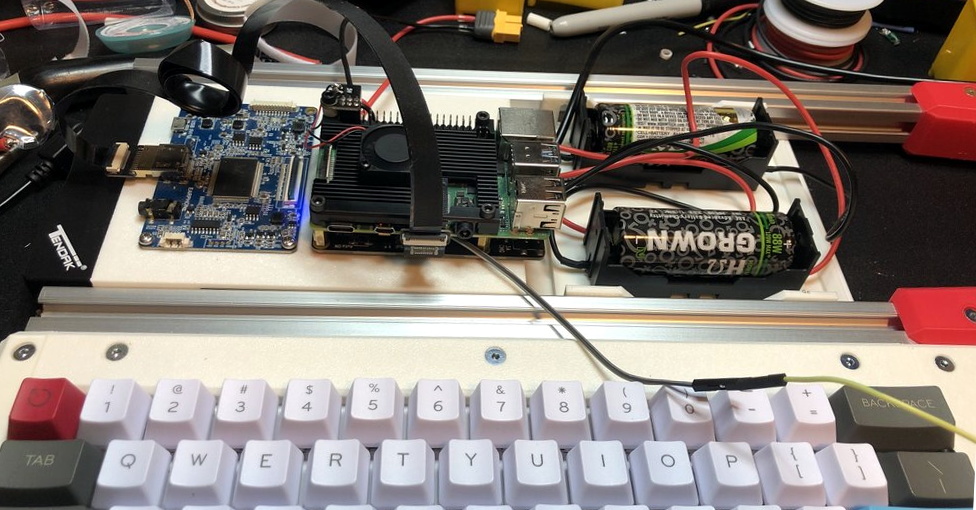Whether we’re talking about Gibson’s Sprawl or our increasingly dystopian reality, one of the defining characteristics of a cyberdeck is that it can be easily customized and upgraded over time. While a few of the builds we’ve covered over the last couple of years have focused more on style than substance, we really appreciate the designs that embrace the concept of modularity to make sure the system can evolve to meet the changing demands of hacking on the go.
To that end, the M3TAL from [BlastoSupreme] is a perfect example of what a cyberdeck should be. Naturally it’s got the cyberpunk aesthetics we’ve come to expect, but more importantly, it’s designed so modifications and repairs are as quick and painless as possible. The trick is the use of a 2020 aluminum extrusion frame, which allows external panels and components to be attached anywhere along the length of the deck using T-Nuts. Similarly, by mounting internal components to “sleds” that ride between the pieces of extrusion, the electronics can easily be removed or swapped out as complete modules.

Furthering the idea of expandability, [BlastoSupreme] included an authentic 3.5 floppy drive on the M3TAL that allows him to pack an incredible 1.44 MB onto each rugged and portable disk. OK, so maybe the floppy drive isn’t terribly impressive compared to 2021 tech, but it does seem oddly appropriate for a cyberdeck. On the opposite side of the deck there’s a RetroCART slot, which cloaks modern USB devices in clunky faux cartridges. This provides a unified physical format for everything from removable storage to microcontrollers and software defined radio receivers.
[BlastoSupreme] also put quite a bit of time and effort into the input devices on the M3TAL. There’s a mechanical keyboard onboard, as is something of a tradition for cyberdecks, but this one is notable for the meticulous hand-wiring and Teensy 2.0 microcontroller hiding underneath. Next to that is a small joystick intended for the Nintendo Switch which has been converted to USB by way of an Arduino Pro Micro.
Looking at the M3TAL, it probably won’t surprise you to hear that this isn’t the first custom cyberdeck [BlastoSupreme] has built. Last year we covered his gargantuan NX-Yamato, and it’s interesting to see the evolution of his technique. Clearly this isn’t a maker who’s content to rest on his laurels, so we’re eager to see what he’s got in store for his next project.


















Design reminds me of some point of sale terminals.
An old POS, might be a good starting block for building a Syb-R deck!
B^)
An old POS’d have a massive CRT. Post 2004 or so might be a good target.
Sorry, couldn’t understand your comment – can you try again without the whining ?
whoops, never mind :)
What’s that PCB under the Pi? (Hardware attached on bottom? HAB?)
Probably the battery controller – and I wonder what kind of battery life this is getting.
It’s a geekworm x705 power board.
battery-powered pi. thumbs down. might as well use a 2010-era intel laptop cpu
Thank you for your encouragement. As a beginner in the electronics hobby it’s so nice to receive positive feedback and constructive criticisms. Thank you so much.
And your suggested board is? (Non ironically). I mean – Pi consumes up to about 3 amps on full power (Pi4). Display – at about 1/4 of that (well, guesstimate).
What are these cyberdecks used for exactly?
What do you use your computer for now?
I remember trying to use my Model 100 in a park around 1987, and I got a lot of stares.
Now laptops and even smaller devices are common. So you need to make your own, and make it distinctive, if you want to stand out in a crowd.
DIY Boombox.
@Greg A The raspberry pi is going to be much cooler, cheaper, and use less power than an old x86 cpu… It is pretty much better in every way than doing that.
Not really ARM is extremely power inefficient they use x2.5-x10 more power to make thing done + proprietary not standardize loader make them unusable for low level hacking, then you can install Coreboot/Tianocore on old x86 board.
You can as well buy modern ryzen SBC(they often used in NUC-like HTPC) but they start from $200, of course if even you can find a one(consider modern shortage), old AMD APU or Atom you can get as low as $50.
A halfway decently documented ARM board is if anything more suitable to low level tinkering, as you don’t get the BIOS hiding what is actually being done… The whole device tree system and extra learning you need to do to make it happen is a downside from one point of view, but its part of understanding how it all works!
Also ARM really isn’t power inefficient at all, there is a reason why chromebooks and phones where battery life is high on the list of priority are all ARM/RISC systems, its more efficient in general! There are certainly going to be particular applications that are more or less power hungry as they optimise well with the CISC of x86, and if you compare a tiny 2watt processor with small ram to a 300w giant with 128gb for a particularly intensive task it might well be less power efficient as it spends so much time paging, but you really are not comparing like for like, though even then while the pi might take significantly longer its often still more power efficient as it isn’t powering lots of active cooling and the rather hungry cpu/gpu that is mostly idle waiting on the other of the pair, it just took all night sucking it its maximum where the CPU/GPU combo in a workstation might do the job in an hour..